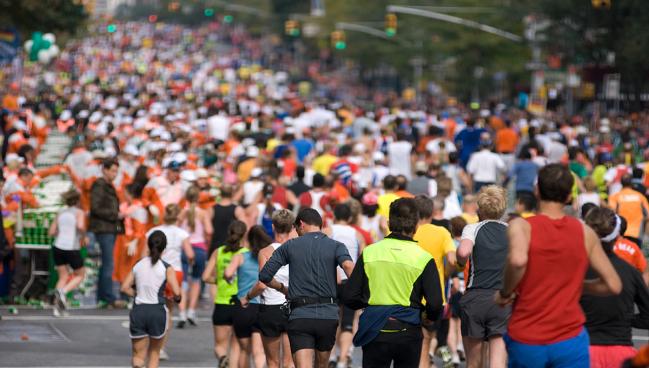RACER: No Change in Cardiac Arrests During Marathons, but Survival Is Up
For every 100,000 runners who complete the full 42.2 km distance, there will be one cardiac arrest, new data show.

CHICAGO, IL—Despite more and more Americans participating in long-distance running races, the incidence of sudden cardiac arrest during these events has remained relatively stable over a recent 10-year period, the RACER study shows.
Among nearly 30 million US adults who finished a marathon (26.2 mi or 42.2 km) or half-marathon (13.1 mi or 21.1 km) between 2010 and 2023, the overall incidence of sudden cardiac arrest was 0.60 per 100,000 runners. The risk of cardiac arrest was higher in men than in women and in those who ran a full versus half marathon.
While the incidence compares favorably with what was seen in a prior study looking at the risk of sudden cardiac arrest during distance running events between 2000 to 2009, researchers say there is more to be done.
“We’re still at the point where roughly one in 100,000 people who run a marathon are going to have a cardiac arrest,” senior investigator Aaron Baggish, MD (Lausanne University Hospital, Switzerland), told TCTMD. “If you think about a New York or Chicago marathon in the same year, one person is going to have an arrest and that hasn’t changed. What that means is that we’re still not doing any better at identifying people who are at risk.”
The upside of the new data is that the risk of dying from sudden cardiac arrest has declined significantly since 2000-2009, with investigators saying race-course preparedness, which involves an emergency action protocol with immediate access to defibrillators, has likely led to improved survival.
“This is where I think you can convincingly use the term good news,” said Baggish. “We are doing a better job at resuscitating them.”
We’re still at the point where roughly one in 100,000 people who run a marathon are going to have a cardiac arrest. Aaron Baggish
Lead investigator Jonathan Kim, MD (Emory University School of Medicine, Atlanta, GA), who presented the study last week at the American College of Cardiology (ACC) 2025 Scientific Session, said that long-distance Masters runners—those ages 35 years and older—are often considered an emblem of optimal health, but this doesn’t mean they are immune from atherosclerotic cardiovascular disease. In their prior analysis, many of the older athletes who arrested had evidence of ischemic heart disease, with some runners even complaining of symptoms.
For those athletes with cardiovascular risk factors, “you don’t want to assume just because they’re at high cardiovascular fitness that there’s nothing to do here,” Kim told TCTMD. “There is a very strong rationale to go through how you would handle anybody in those circumstances as you think about their risk factors, what medicines they should be on, and take in the various kind of assessments they may need as it relates to their ability to engage in ultra-endurance, high-intensity-type exercise.”
Both Baggish and Kim stressed the data should not stimulate “untargeted screening” of men and women simply because they run long distances.
“What we do think is important is for all doctors to remember that no patient that walks into their office is fit enough or runs enough to outrun the risk that comes with traditional risk factors,” said Baggish. “If those are identified, they need to be addressed regardless of what someone’s doing with their running and their weekend marathoning.”
Stable Incidence over 23 Years
RACER is a prospective, observational case series of US marathon and half-marathon runners designed to capture the incidence, outcomes, and causes of cardiac arrest during races. The first RACER report, which was published in 2012, included a little less than 11 million runners who participated in events between 2000 and 2009. In that study, the incidence of cardiac arrest was 0.54 per 100,000 runners, a risk that was highest in marathoners and in men.
The new report, which was published simultaneously in JAMA, looked at 29,311,597 race finishers of marathon and half-marathon running races certified and sanctioned by USA Track and Field (USATF). Cardiac arrests were identified through media sources, by contacting all race directors, and through injury reports filed by the USATF.
Between 2010 and 2023, there were 176 sudden cardiac arrests, or 0.60 events per 100,000 runners. The proportion of arrests was mostly stable between 2010 to 2019 but increased slightly between 2020 and 2023. Among men, the incidence was 1.12 per 100,000 compared with 0.19 per 100,000 women. Like the prior study, the risk of arrest was higher in those who ran marathons compared with those who ran the half marathons (1.04 vs 0.47 per 100,000).
Of the 176 arrests, 59 people died, which is significantly lower than in the analysis from 2000-2009 (34% vs 71%; P < 0.001). The overall incidence of cardiac death also was lower in the new analysis than in the prior study period (0.20 vs 0.39 per 100,000 people).
The cause of cardiac arrest was available in 67 cases, the most common being coronary artery disease (40%). Hypertrophic cardiomyopathy (HCM) was identified as the cause in just five cardiac arrests, including three individuals who survived.
No patient that walks into their office is fit enough or runs enough to outrun the risk that comes with traditional risk factors. Jonathan Kim
Comprehensive clinical profiles were available for 36 people, including 19 runners who survived. Among those with coronary artery disease, both plaque rupture and stable disease were reported. For seven runners who died of sudden arrhythmic death, which was confirmed by autopsy, three had genetic variants of uncertain significance in cardiomyopathy. Bystander CPR was performed in all 36 cardiac arrests and there was “near-universal use” of automated external defibrillators (AEDs), reported researchers. An AED was unavailable in three instances where a death occurred.
During the ACC presentation, Meagan Wasfy, MD (Massachusetts General Hospital, Boston, MA), pointed out that there was a shift in the etiology of cardiac arrest between 2000-2009 and 2010-2023. In the prior study, HCM, and possible HCM, were the most common causes of death, and she questioned whether this was a true shift or a reflection of the challenges in ascertaining the cause of death.
“I believe, similar to what we see in young competitive athletes, this is really more an issue of case ascertainment of prior studies,” replied Kim. “In retrospect, looking back to RACER (2000-2009), I’m not completely convinced that there was as much true hypertrophic cardiomyopathy as was previous published at the time.”
Race Planning Likely Improves Survival
The decline in cardiac arrest mortality is likely the result of better race planning, say the researchers. The demographics of long-distance running haven’t changed, but course directors have worked with medical teams to develop emergency action plans in the case of a cardiac arrest. Bystander CPR and the “near-immediate deployment and use” of AEDs positively affected outcomes, they say.
Emergency action plans, among other key elements, ensure that staff, volunteers, and other personnel are trained in CPR and AED use, with defibrillators placed at easily accessible locations throughout the racecourse and at all medical stations. Planning also anticipates how quickly emergency personnel can get to the runner if there is an event.
“The idea is to get the amount of time from when the runner collapses to when that defibrillator is put on to be as little as possible, ideally less than 3 minutes,” said Baggish, who served as co-medical director of the Boston Marathon for more than a decade.
Kim, who is the medical director of the Peachtree Road Race, a 10-km race that attracts roughly 60,000 runners each year, noted that the risk of arrest is greatest near the end of a race, something that is accounted for in emergency planning.
Regarding the slight uptick in cardiac arrests between 2020 and 2023, Baggish and Kim said the reasons are unknown. Clinical myocarditis related SARS-CoV-2 infection among competitive athletes during the COVID-19 pandemic was uncommon and myocarditis was not seen among the cardiac arrest cases with complete clinical profiles during this period. It’s possible that some runners avoided the healthcare system during the pandemic, which may have led to decreased detection of cardiovascular disease. Another hypothesis is that the period saw a new wave of runners coping with the pandemic, but that is speculative at this point. It’s also possible the uptick is simply a blip that can occur in epidemiologic studies, said Kim.
Michael O’Riordan is the Managing Editor for TCTMD. He completed his undergraduate degrees at Queen’s University in Kingston, ON, and…
Read Full BioSources
Kim JH, Rim AJ, Miller JT, et al. Cardiac arrest during long-distance running races. JAMA. 2025;Epub ahead of print.
Disclosures
- Kim reports grant funding from the Atlanta Track Club and the National Institutes of Health.
- Baggish reports grant funding/consultancy compensation from the National Football League Players Association, American Heart Association, US Olympic Committee/US Olympic Training Centers, US Soccer, and Trek-Lidl Cycling.





Comments